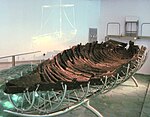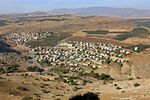Tarichaea
Tarichaea (Greek: Ταριχαία, Tarichaia) is the Greek place name for a historic site of disputed location. It was situated along the shore of the Sea of Galilee, and mentioned in the writings of Josephus (Ant. 14.120; 20.159; The Jewish War 1.180; 2.252; Vita 32, et al.). Tarichaea was one of the first villages in Galilee to have sustained an attack by Rome, during the First Jewish-Roman War. The village (κώμη) attracted to it the seditious from the outlying regions east of Galilee, who mixed with the local townsfolk and who relied upon some 230 boats on the Sea of Galilee for protection in the event of an assault upon the village. When the village was eventually overrun by the Roman army, the population surrendered.
Excerpt from the Wikipedia article Tarichaea (License: CC BY-SA 3.0, Authors).Tarichaea
Migdal
Geographical coordinates (GPS) Address Nearby Places Show on map
Geographical coordinates (GPS)
| Latitude | Longitude |
|---|---|
| N 32.825 ° | E 35.515555555556 ° |
Address
1427943 Migdal
North District, Israel
Open on Google Maps









